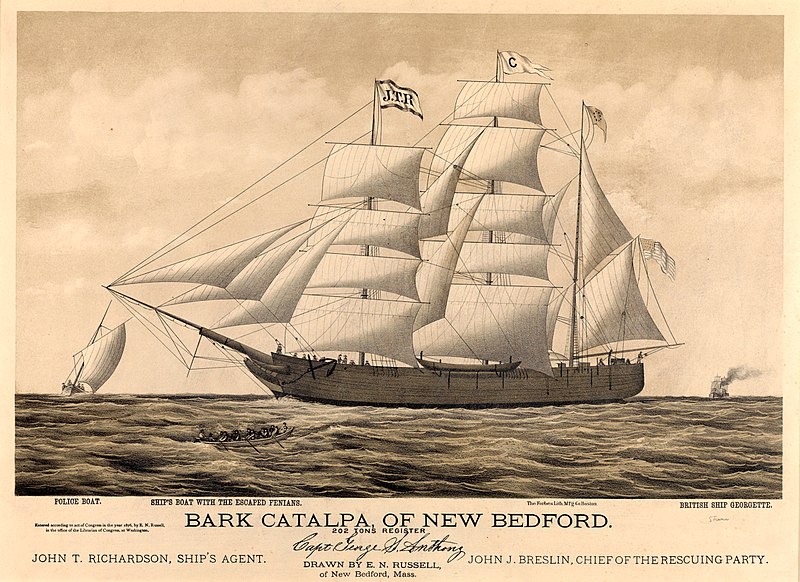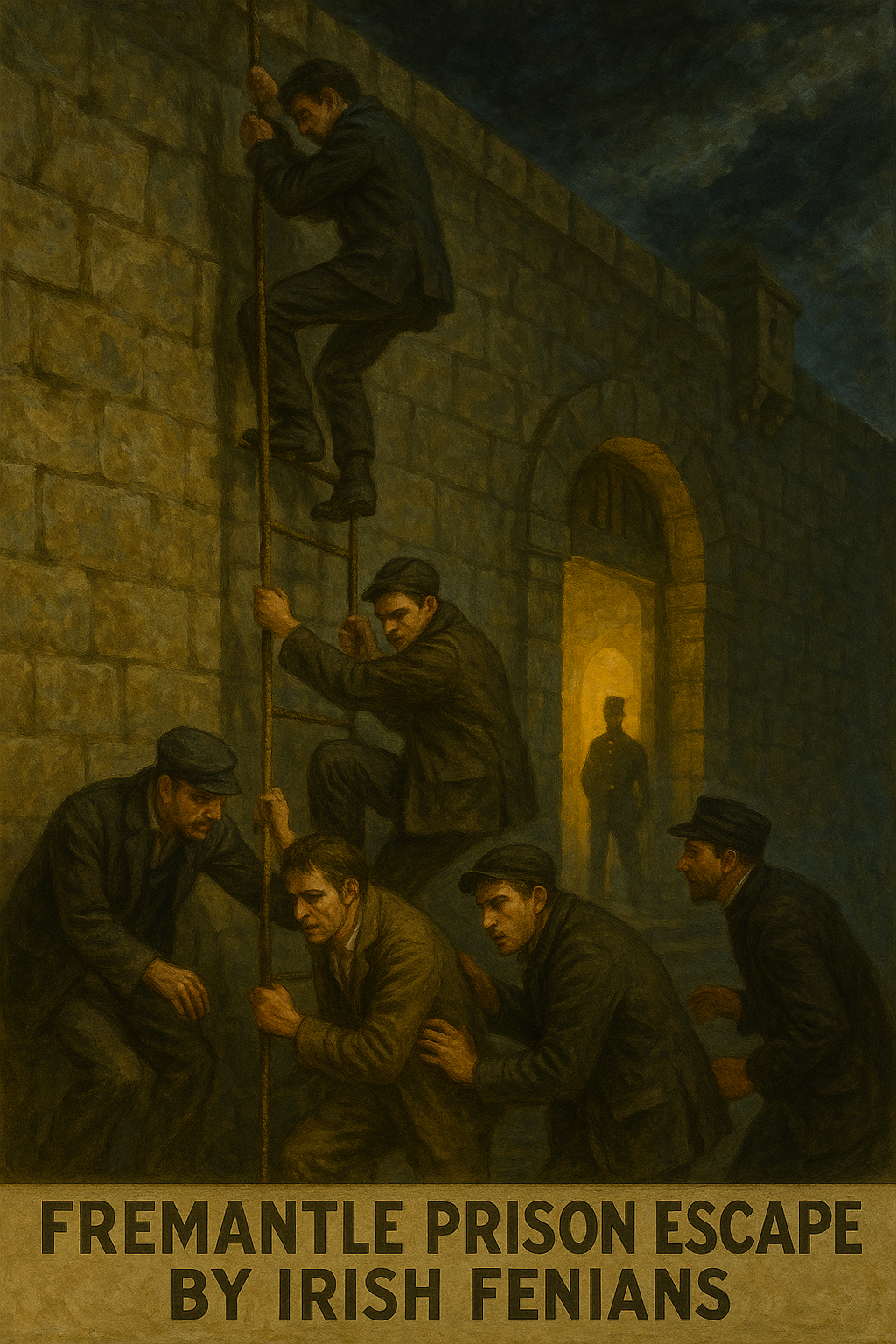
In the desolate heart of Western Australia’s penal colony, where the sun scorched the earth with imperial cruelty, a spark of defiance blazed.
These men, exiles of Ireland’s 1860s uprisings, carried the fire of the Fenian Brotherhood across oceans, their spirits unbowed.
Their escape was a love letter to liberty, a vow that shook the foundations of empire.
For more tales of Ireland’s unquenchable spirit, explore Secret Ireland’s rebellion chronicles.
Why Did the Catalpa Rescue Happen? The Cry from a Living Tomb
Because oppression breeds rebellion, and the Irish were forged in its flames.
The Fenian Brotherhood, sworn to Ireland’s independence, had been crushed by Britain’s iron fist in the 1860s.
Sixty-two rebels were shipped to Fremantle on the convict ship Hougoumont, arriving January 9, 1868, their dreams chained.
The Fenian uprisings had failed, but their embers smoldered in the hearts of these exiles.
In Fremantle Prison, they faced a living tomb—starvation, brutal labor, and the empire’s contempt.
The Catalpa Rescue tells of James Wilson, a Fenian who penned a desperate plea to John Devoy in 1874.
“This is a voice from the tomb,” he wrote, his words a cry from a soul devoured by nine years of torment.
Pardons in 1869 and 1871 freed many Fenians, but a defiant few—military rebels—remained in chains.
Wilson’s letter was no mere request; it was a sacred vow, a call to arms that would not be ignored.
The Catalpa Rescue was born from this plea, a plan to snatch freedom from the jaws of empire.
It was Ireland’s heart beating in Australia’s dust, a rebellion against the chains of despair.
Who Was Involved in the Catalpa Rescue? Heroes of the Wild Geese
John Devoy, a Fenian exiled to New York, was the mastermind, his pen a sword.
John Boyle O’Reilly, a Fenian who escaped Fremantle in 1869, was the spark, now editor of Boston’s The Pilot.
James Wilson, Thomas Darragh, Martin Hogan, Michael Harrington, Thomas Hassett, and Robert Cranston were the six who fled.
These men, dubbed the “Wild Geese” after Ireland’s exiled soldiers, were warriors of a lost cause, their souls unyielding.
Captain George Smith Anthony, a Yankee whaler, helmed the Catalpa, his heart won by the Irish cause.
John Breslin and Thomas Desmond, Fenian agents, worked undercover in Fremantle, their guile the key to freedom.
The Catalpa Rescue documentary sources paint them as poets of rebellion, their courage a hymn to liberty.
They faced the New South Wales Corps, Governor William Cleaver Robinson, and the might of Britain’s naval power.
Their story echoes the defiance of Thomas Francis Meagher, Ireland’s patriot and America’s Civil War hero.
From Fremantle’s cells to New York’s streets, these men were bound by a shared dream of Ireland unchained.
They were the damned, the exiled, the unbreakable, and their escape was a poem written in salt and blood.
What Happened in the Catalpa Rescue? A Dance with Destiny

On April 17, 1876, at 8:30 a.m., the air crackled with defiance.
Six Fenians—Wilson, Darragh, Hogan, Harrington, Hassett, and Cranston—slipped from Fremantle Prison’s work parties.
The Catalpa Rescue summary tells of a whaleboat, dispatched by Captain Anthony, waiting at Rockingham’s shore.
Breslin and Desmond, disguised as businessmen, spirited the men in horse traps to the pier, 20 kilometers south.
They rowed through a squall that shattered the whaleboat’s mast, their lives hanging by a thread.
The Catalpa Rescue PDF accounts describe a storm so fierce Anthony feared the boat would not survive.
By dawn on April 18, they reached the Catalpa, anchored in international waters, a beacon of hope.
But the British were not idle. The steamer Georgette, commandeered by Governor Robinson, gave chase.
The Fenians hid in the whaleboat, unseen by Georgette, which retreated to Fremantle for coal.
A police cutter, bristling with armed men, raced to intercept, but the whaleboat reached Catalpa first.
On April 19, Georgette returned, armed with a cannon, demanding the prisoners’ surrender.
Anthony hoisted the U.S. flag, daring Britain to risk war. The Georgette backed down, and freedom won.
What Was the Outcome of the Catalpa Rescue? A Triumph of the Spirit
What was the outcome of the Catalpa Rescue? The six Fenians sailed to New York, arriving August 19, 1876.
Their escape sparked jubilation in America and Ireland, a slap to Britain’s imperial pride.
The Catalpa Rescue Wikipedia notes the anger in Britain and Australia, though some Australians cheered the rebels.
No diplomatic crisis ensued; Governor Robinson was glad to see the Fenians become “someone else’s problem.”
Captain Anthony, hailed as a hero, published The Catalpa Expedition in 1897, immortalizing the tale.
John Breslin returned a legend, his courage a beacon for the Clan na Gael until his death in 1887.
The Catalpa was sold, later condemned as a coal barge in Belize, its glory faded but not forgotten.
The rescue inspired the legend of Ned Kelly, another Irish rebel defying empire.
Its legacy burns in memorials—a 2005 statue of six wild geese in Rockingham, a 1976 stone in New Bedford.
The Fenians’ escape was a poem of defiance, a testament to the unbreakable Irish spirit.
It echoed the Castle Hill Rebellion, another Irish stand against oppression.
The Catalpa’s Legacy: A Song of Freedom
The Catalpa Rescue is more than history; it’s a myth, a saga of courage carved in salt and steel.
Fremantle Prison, once a tomb, became a stage for Ireland’s unyielding heart.
The Catalpa Rescue documentary sources tell of a plan so audacious it seemed torn from a poet’s dream.
John Devoy’s cunning, O’Reilly’s fire, and Anthony’s bravery wove a tapestry of rebellion.
The Fenians, dubbed the Wild Geese, published a newspaper, The Wild Goose, aboard the Hougoumont.
Their words, scribbled in chains, were a vow to never surrender their dream of a free Ireland.
The rescue’s success was a beacon, inspiring future fights for justice across the globe.
It proved that even in exile, the Irish spirit could not be caged, its fire unquenchable.
The 19 crimes to be sent to Australia—treason, theft, rebellion—were the empire’s tools to silence dissent.
Yet, in banishing the Fenians, Britain only spread their fire, planting defiance in Australia’s soil.
The Catalpa Rescue is a love song to liberty, a reminder that no chain can bind the human spirit.
Its echo lives in every act of resistance, every heart that dares to dream of freedom.
Like the dark legends of Ireland, it’s a story of raw, unyielding humanity.
The memorials in Rockingham and New Bedford stand as altars to the Wild Geese’s courage.
The Catalpa Rescue is Ireland’s heart beating in Australia’s dust, a flame that will never die.
It’s a call to all who fight against oppression, a hymn that echoes through the ages.
Frequently Asked Questions About the Catalpa Rescue
What Happened in the Catalpa Rescue? A Defiant Flight
What happened in the Catalpa Rescue?
On April 17, 1876, six Irish Fenians broke free from Fremantle’s iron grip.
They fled work parties, racing to a whaleboat waiting at Rockingham’s shore.
A squall nearly drowned them, but they reached the Catalpa, a ship of hope.
British pursuit failed; the U.S. flag shielded them from capture.
They sailed to New York, their escape a triumph of Irish defiance.
Dive into more rebel tales at Secret Ireland’s rebellion stories.
How Many Died in the Catalpa Rescue? A Bloodless Victory
How many people died in the Catalpa Rescue?
No lives were lost in the Catalpa Rescue, a miracle of cunning over force.
The Fenians faced a storm that shattered their whaleboat’s mast, yet survived.
British pursuit—Georgette and a police cutter—fired no fatal shots.
The Catalpa Rescue PDF calls it a bloodless rebellion, a rare triumph.
Their victory was in stealth, not slaughter, a poet’s escape from empire.
Why Was the Fenian Movement Significant Despite Its Failures?
Why was the 1798 rebellion significant even though it failed?
The Fenian movement was Ireland’s soul screaming for freedom, a fire unquenched.
Though crushed in the 1860s, it united Irish hearts against British tyranny.
Its failures sowed the seeds of modern Irish nationalism, a legacy of defiance.
The Catalpa Rescue Wikipedia ties it to the Catalpa’s triumph, a spark carried abroad.
Explore this fire at Secret Ireland’s rebellion archives.
What Is Fremantle Prison Famous For? A Tomb of Defiance
What is Castle Hill famous for?
Fremantle Prison is a monument to suffering, where Fenians defied their chains.
The 1876 Catalpa Rescue, a daring escape, is its most legendary chapter.
Its cells held the Wild Geese, whose spirit soared beyond iron bars.
Today, it’s a UNESCO site, its walls whispering tales of rebellion.
It shares the fire of Castle Hill’s rebellion.
What Were the 19 Crimes That Led to Australia’s Exile?
What were the 19 crimes to be sent to Australia?
Empire’s laws were a noose, exiling men for sins both petty and bold.
The 19 crimes included treason, theft, forgery, and rebellion.
For Fenians, their crime was dreaming of an Ireland free from Britain’s yoke.
These sentences forged Australia’s heart, a nation of defiant exiles.
Their legacy burns in stories like Ned Kelly’s legend.
Which Country Fueled the Catalpa Rescue’s Fire?
Which country did most of the Catalpa Rescue rebels come from?
Ireland was the heartbeat of the Catalpa Rescue, its rebels pure emerald fire.
The six Fenians were Irish, scarred by the 1860s fight for independence.
Exiled on the Hougoumont, they carried their homeland’s dream to Australia.
Their escape was Ireland’s song, sung under a foreign sky.
Meet another Irish hero at Thomas Francis Meagher’s story.
When Did the Catalpa Rescue Begin and End?
When did the Catalpa Rescue start and end?
The Catalpa Rescue began on April 17, 1876, with a daring dash from Fremantle.
By April 19, the Fenians were free, sailing beyond Britain’s reach.
The Catalpa Rescue documentary captures this three-day saga of defiance.
Their journey to New York ended August 19, 1876, a triumph sealed.
It was a fleeting rebellion, its echo eternal in history’s heart.



